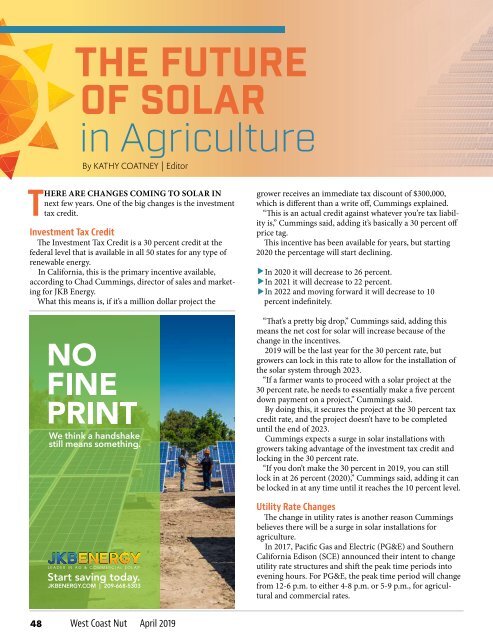WCN April 2019
You also want an ePaper? Increase the reach of your titles
YUMPU automatically turns print PDFs into web optimized ePapers that Google loves.
The Future<br />
of Solar<br />
in Agriculture<br />
By KATHY COATNEY | Editor<br />
THERE ARE CHANGES COMING TO SOLAR IN<br />
next few years. One of the big changes is the investment<br />
tax credit.<br />
Investment Tax Credit<br />
The Investment Tax Credit is a 30 percent credit at the<br />
federal level that is available in all 50 states for any type of<br />
renewable energy.<br />
In California, this is the primary incentive available,<br />
according to Chad Cummings, director of sales and marketing<br />
for JKB Energy.<br />
What this means is, if it’s a million dollar project the<br />
grower receives an immediate tax discount of $300,000,<br />
which is different than a write off, Cummings explained.<br />
“This is an actual credit against whatever you’re tax liability<br />
is,” Cummings said, adding it’s basically a 30 percent off<br />
price tag.<br />
This incentive has been available for years, but starting<br />
2020 the percentage will start declining.<br />
In 2020 it will decrease to 26 percent.<br />
In 2021 it will decrease to 22 percent.<br />
In 2022 and moving forward it will decrease to 10<br />
percent indefinitely.<br />
“That’s a pretty big drop,” Cummings said, adding this<br />
means the net cost for solar will increase because of the<br />
change in the incentives.<br />
<strong>2019</strong> will be the last year for the 30 percent rate, but<br />
growers can lock in this rate to allow for the installation of<br />
the solar system through 2023.<br />
“If a farmer wants to proceed with a solar project at the<br />
30 percent rate, he needs to essentially make a five percent<br />
down payment on a project,” Cummings said.<br />
By doing this, it secures the project at the 30 percent tax<br />
credit rate, and the project doesn’t have to be completed<br />
until the end of 2023.<br />
Cummings expects a surge in solar installations with<br />
growers taking advantage of the investment tax credit and<br />
locking in the 30 percent rate.<br />
“If you don’t make the 30 percent in <strong>2019</strong>, you can still<br />
lock in at 26 percent (2020),” Cummings said, adding it can<br />
be locked in at any time until it reaches the 10 percent level.<br />
Utility Rate Changes<br />
The change in utility rates is another reason Cummings<br />
believes there will be a surge in solar installations for<br />
agriculture.<br />
In 2017, Pacific Gas and Electric (PG&E) and Southern<br />
California Edison (SCE) announced their intent to change<br />
utility rate structures and shift the peak time periods into<br />
evening hours. For PG&E, the peak time period will change<br />
from 12-6 p.m. to either 4-8 p.m. or 5-9 p.m., for agricultural<br />
and commercial rates.<br />
48<br />
West Coast Nut <strong>April</strong> <strong>2019</strong>


















